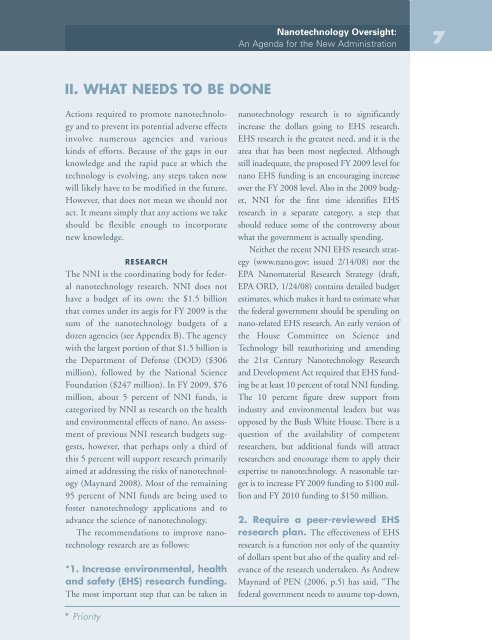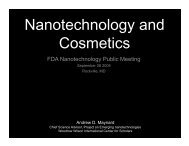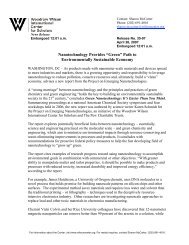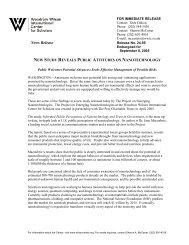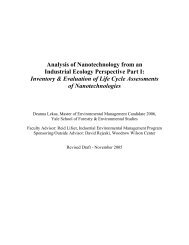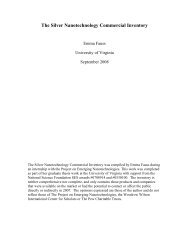nanotechnology oversight - Project on Emerging Nanotechnologies
nanotechnology oversight - Project on Emerging Nanotechnologies
nanotechnology oversight - Project on Emerging Nanotechnologies
Create successful ePaper yourself
Turn your PDF publications into a flip-book with our unique Google optimized e-Paper software.
Nanotechnology Oversight:<br />
An Agenda for the New Administrati<strong>on</strong><br />
7<br />
II. WHAT NEEDS TO BE DONE<br />
Acti<strong>on</strong>s required to promote <str<strong>on</strong>g>nanotechnology</str<strong>on</strong>g><br />
and to prevent its potential adverse effects<br />
involve numerous agencies and various<br />
kinds of efforts. Because of the gaps in our<br />
knowledge and the rapid pace at which the<br />
technology is evolving, any steps taken now<br />
will likely have to be modified in the future.<br />
However, that does not mean we should not<br />
act. It means simply that any acti<strong>on</strong>s we take<br />
should be flexible enough to incorporate<br />
new knowledge.<br />
RESEARCH<br />
The NNI is the coordinating body for federal<br />
<str<strong>on</strong>g>nanotechnology</str<strong>on</strong>g> research. NNI does not<br />
have a budget of its own: the $1.5 billi<strong>on</strong><br />
that comes under its aegis for FY 2009 is the<br />
sum of the <str<strong>on</strong>g>nanotechnology</str<strong>on</strong>g> budgets of a<br />
dozen agencies (see Appendix B). The agency<br />
with the largest porti<strong>on</strong> of that $1.5 billi<strong>on</strong> is<br />
the Department of Defense (DOD) ($306<br />
milli<strong>on</strong>), followed by the Nati<strong>on</strong>al Science<br />
Foundati<strong>on</strong> ($247 milli<strong>on</strong>). In FY 2009, $76<br />
milli<strong>on</strong>, about 5 percent of NNI funds, is<br />
categorized by NNI as research <strong>on</strong> the health<br />
and envir<strong>on</strong>mental effects of nano. An assessment<br />
of previous NNI research budgets suggests,<br />
however, that perhaps <strong>on</strong>ly a third of<br />
this 5 percent will support research primarily<br />
aimed at addressing the risks of <str<strong>on</strong>g>nanotechnology</str<strong>on</strong>g><br />
(Maynard 2008). Most of the remaining<br />
95 percent of NNI funds are being used to<br />
foster <str<strong>on</strong>g>nanotechnology</str<strong>on</strong>g> applicati<strong>on</strong>s and to<br />
advance the science of <str<strong>on</strong>g>nanotechnology</str<strong>on</strong>g>.<br />
The recommendati<strong>on</strong>s to improve <str<strong>on</strong>g>nanotechnology</str<strong>on</strong>g><br />
research are as follows:<br />
*1. Increase envir<strong>on</strong>mental, health<br />
and safety (EHS) research funding.<br />
The most important step that can be taken in<br />
<str<strong>on</strong>g>nanotechnology</str<strong>on</strong>g> research is to significantly<br />
increase the dollars going to EHS research.<br />
EHS research is the greatest need, and it is the<br />
area that has been most neglected. Although<br />
still inadequate, the proposed FY 2009 level for<br />
nano EHS funding is an encouraging increase<br />
over the FY 2008 level. Also in the 2009 budget,<br />
NNI for the first time identifies EHS<br />
research in a separate category, a step that<br />
should reduce some of the c<strong>on</strong>troversy about<br />
what the government is actually spending.<br />
Neither the recent NNI EHS research strategy<br />
(www.nano.gov; issued 2/14/08) nor the<br />
EPA Nanomaterial Research Strategy (draft,<br />
EPA ORD, 1/24/08) c<strong>on</strong>tains detailed budget<br />
estimates, which makes it hard to estimate what<br />
the federal government should be spending <strong>on</strong><br />
nano-related EHS research. An early versi<strong>on</strong> of<br />
the House Committee <strong>on</strong> Science and<br />
Technology bill reauthorizing and amending<br />
the 21st Century Nanotechnology Research<br />
and Development Act required that EHS funding<br />
be at least 10 percent of total NNI funding.<br />
The 10 percent figure drew support from<br />
industry and envir<strong>on</strong>mental leaders but was<br />
opposed by the Bush White House. There is a<br />
questi<strong>on</strong> of the availability of competent<br />
researchers, but additi<strong>on</strong>al funds will attract<br />
researchers and encourage them to apply their<br />
expertise to <str<strong>on</strong>g>nanotechnology</str<strong>on</strong>g>. A reas<strong>on</strong>able target<br />
is to increase FY 2009 funding to $100 milli<strong>on</strong><br />
and FY 2010 funding to $150 milli<strong>on</strong>.<br />
2. Require a peer-reviewed EHS<br />
research plan. The effectiveness of EHS<br />
research is a functi<strong>on</strong> not <strong>on</strong>ly of the quantity<br />
of dollars spent but also of the quality and relevance<br />
of the research undertaken. As Andrew<br />
Maynard of PEN (2006, p.5) has said, “The<br />
federal government needs to assume top-down,<br />
* Priority


